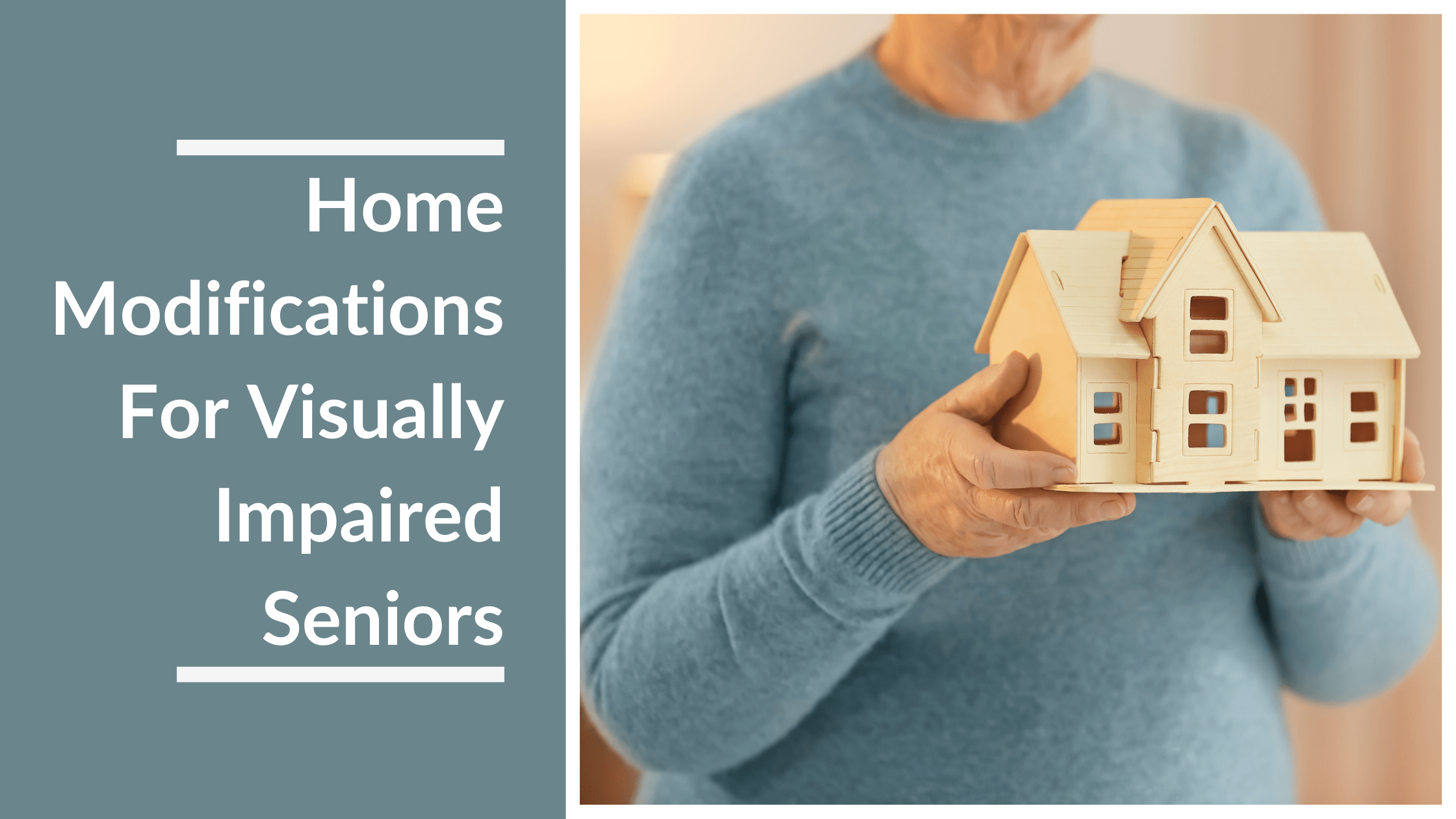
Home modifications for visually impaired seniors are critical for safety and overall wellbeing. Keep reading to find out 22 ways you can create a functional living environment without breaking the bank.
Home Modifications For Visually Impaired Older Adults
Experts predict that visually impaired older Americans will reach 8 million by 2050 — double than in 2016. Unfortunately, for many people, diminished vision is inevitable with age. Older adults with age-related macular degeneration (AMD), low vision, or blindness may have difficulty navigating their home, performing daily tasks, or taking care of themselves. Because of this, they may experience depression, a loss of independence, or lower wellbeing.
So if your loved one has low vision and wishes to remain at home, home remodeling for aging in place can help them keep their independence and quality of life. There are many ways to make a safer, more comfortable home for visually impaired elders without breaking the bank.
Creating a functional living space free of harm is essential for seniors and their families and caregivers. With proper research and planning, you can make a more accommodating home for your loved one without spending a fortune. And while some more thorough modifications are beneficial, you don’t need to complete them all together. With that said, here are 22 home modifications for visually impaired or blind older adults.
Modifications For The Whole Home
Of course, these changes aren’t limited to a single room. So if your loved one would benefit from modifying a particular space, go ahead and implement it!
1. Remove Tripping & Falling Hazards
Falling is a significant concern for seniors whether or not they have a visual impairment. Your loved one deserves to feel safe inside their home, so ensure their safety and give you peace of mind by getting rid of (or re-arranging) things that could cause an accident.
Here are a few ways to reduce the risk of falls:
- Remove walkway obstructions.
- Push in desks and chairs.
- Clean and polish floors with products that won’t cause skids or glares.
- Replace coffee tables or end tables that sit low to the floor with taller items.
- Move cords from walkways or secure them to the floor.
- Replace worn carpets or rugs and secure area rugs with carpet tape.
- Make sure floors are dry. A Swiffer or similar household product can help your loved one clean up spills right away.
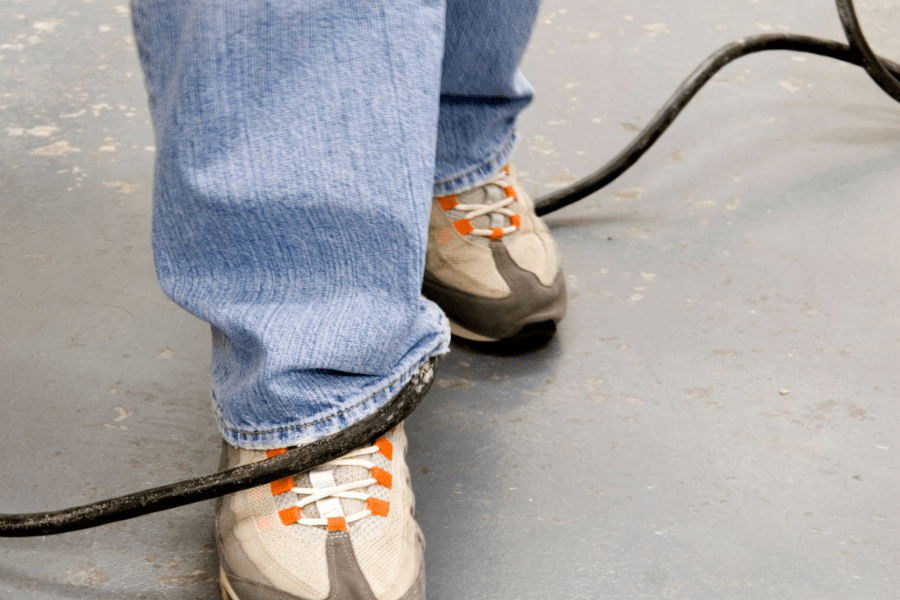
2. Make Light Switches Visible
Light switches that blend into the wall’s surface can be hard to locate, so replace older wall plates with new ones that stand out from the rest of the wall. Plus, light switch plates are inexpensive and available at your local hardware store.
3. Avoid Busy Floor Patterns
For those with diminished eyesight, flooring with busy patterns such as stripes can be visually confusing or cause discomfort. So when considering your loved one’s flooring, use simple colors and consistent textures to help them distinguish between floor items and furniture.
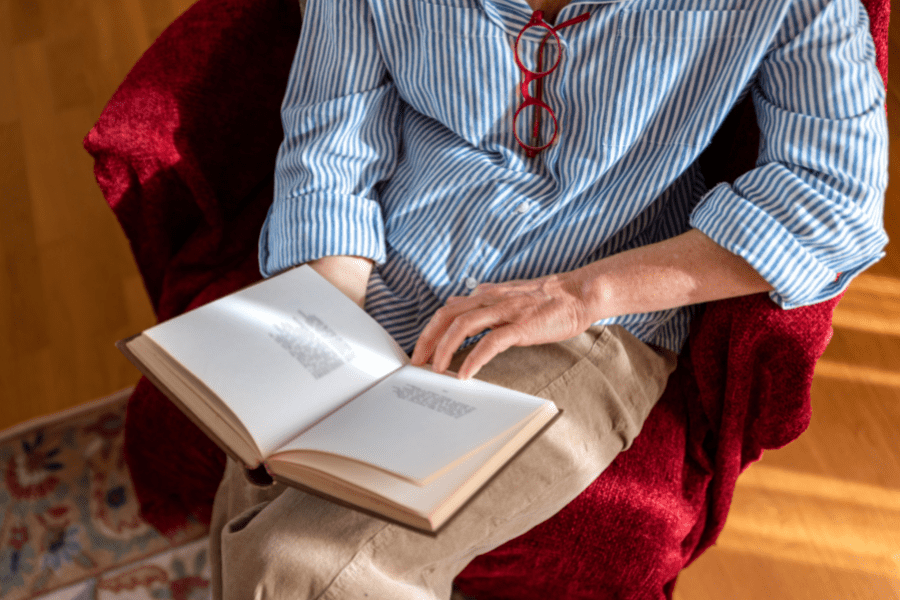
4. Modify Lighting
Of course, if your loved one has diminished vision, a well-lit home is vital. Make sure rooms used for recreation, reading, and socializing have plenty of light. In addition, check that lightbulbs are correctly angled so the light doesn’t shine in your loved one’s eyes.
Here are a few lighting tips for your loved one’s home:
- Incorporate natural light where possible.
- Use nightlights and overhead lamps in hallways.
- Add floor, table, and clip-on lamps in strategic spots.
- Keep flashlights in accessible areas throughout the house.
- Use 60-100 watt bulbs and routinely check for burned out bulbs.
- Test the best lighting for their needs (e.g., halogen, fluorescent, incandescent, or floor lights).
5. Reduce Window Glare
Blinds, drapes, and similar window coverings your loved one can easily adjust are important because they can control how much light comes into the room and avoid glare which could impair everyday tasks.
6. Rearrange Furniture To Create More Space
Move the furniture in your loved one’s home to clear walkways, facilitate movement, and reduce the risk of injury. However, if space limits your options for rearranging, you may want to discuss downsizing with your parents. It’s understandable if your parents feel reluctant about this subject, so approach it with care and understanding.
Here are a few tips for practical and comfortable furniture arrangement:
- Move mirrors away from light source to reduce glare.
- Arrange furniture close together to make it easier to hear and talk with visitors.
- Place seating near windows to increase natural light exposure while working, reading, or performing another activity.
- Use bright vases or lamps and keep them near frequently used furniture to help your loved one locate them more easily.
- If purchasing new furniture for your loved one, look for textured upholstery because it will help your loved one visually differentiate furniture.
Modifications For Halls, Stairs & Doorways
Halls, stairs, and doorways can all pose a fall risk for elders as they move from room to room, so check these areas for changes that could lower their chances of an accidental trip or fall.
7. Distinguish Steps
Whether it’s just two steps or a whole flight, adding contrast to the staircase is one of the most important things you can do to promote your loved one’s safety.
Here are two ideas to help distinguish the edge of each step:
- Add colorful tape strips along the edge of each step.
- Use a stair cover, such as carpet or paint, to add additional contrast from the floor.
Additionally, you could add more contrast by placing a rubber mat or similar textured cover at the bottom of the stairs. Doing so can lower the risk of a misstep and act as a visual indicator to take a step.
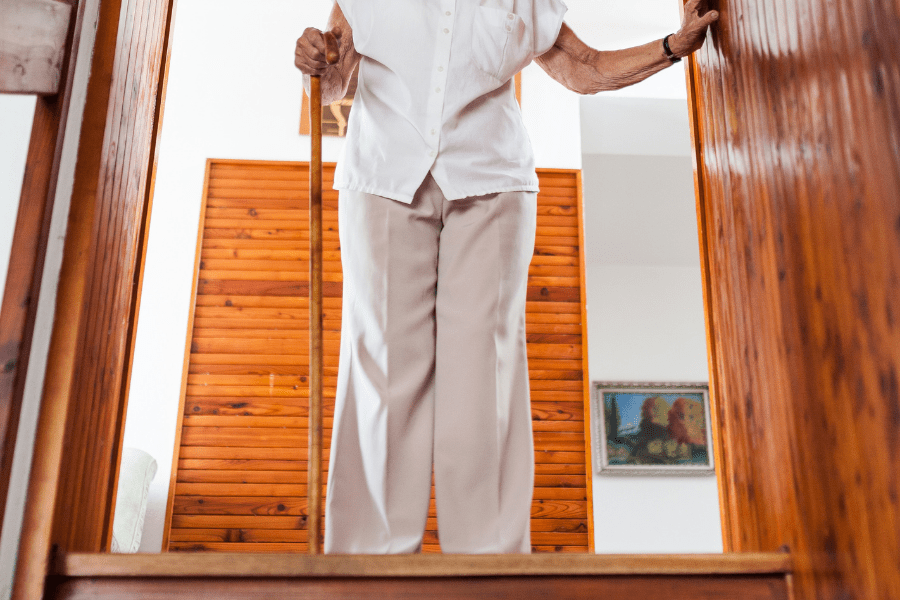
8. Install A Second Railing
Adding railings or handholds to the different levels in your loved one’s home is a must, but installing one on both sides will reinforce security and safety. It’s also a good idea to add similar features like grab rails and handholds throughout the house to make movement easier for your loved one.
9. Add Contrast To Doors & Frames
A fresh coat of paint isn’t just an easy way to give your loved one’s home a facelift. It’s also a simple modification that can make it easier for visually impaired seniors to tell when doors are open or closed.
Kitchen Home Modifications For Visually Impaired Older Adults
The kitchen is a vital part of the house where your loved one likely carries out the most involved tasks during their day. Therefore, you should carefully analyze this space to identify beneficial changes for your loved one.
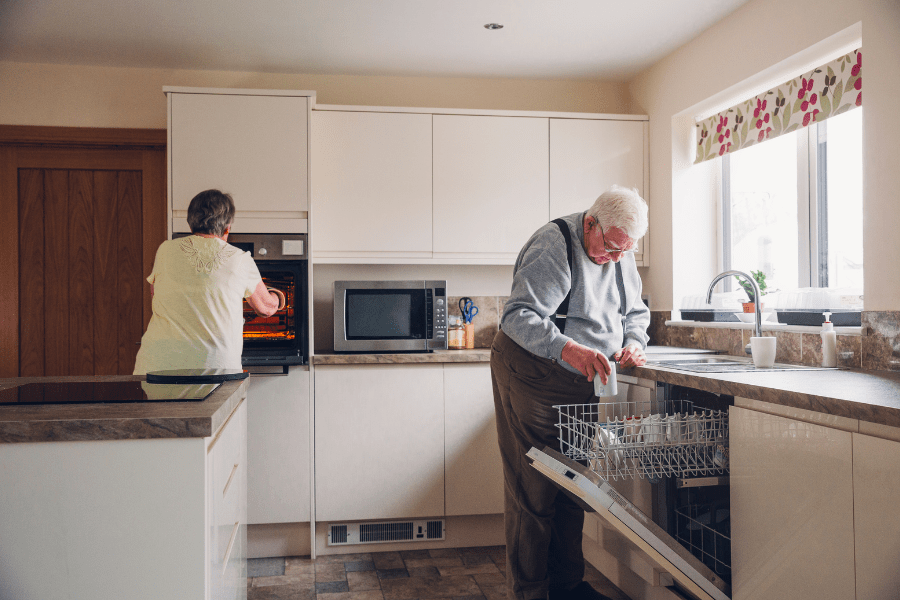
10. Replace Shiny, Slippery Flooring
Ceramic tile flooring can cause glares or be slippery when wet. Installing new floors may be the most costly modification, but it’s worth the price of ensuring your loved one’s safety.
11. Create Contrast Between Counters & Floors
For visually impaired adults, specifically those with diminished central vision, differentiating between the edge of the countertop and the floor can be difficult if the two are close in color.
A simple fix is adding contrast between your loved one’s counters and floors or placing a brightly colored strip (like on the stairs) or a similar decorative element on the edge of the counters.
12. Create Clear Labels For Food & Prescriptions
Organizing your loved one’s food and medications and color-coding container labels based on what’s inside can be an enormous help. Use a basic, sans-serif font and large letters in a color that stands out from the background.
12. Install Under-Cabinet Lighting
Under-cabinet light strips can be an inexpensive modification that makes it easier for older adults to see. Plus, your loved one may even get the bonus of a cheaper energy bill since they don’t have to light the entire kitchen!
Bathroom Home Modifications For Visually Impaired Older Adults
As your loved one ages, bathroom modifications become more of a necessity, no matter the state of their eyesight. Unfortunately, wet surfaces make this room one of the most fall-prone areas of the house, so it’s crucial to make the right changes before an accident happens.
15. Use Non-Slip Bath Mats
The optimal choices are rugs and mats with a rubber backing that also stand out from the bathroom floor.
16. Use Bright-Colored Towels
Like many other household objects, it’s important to use towels that contrast with wall surfaces so your loved one can find them more easily.
17. Add A Magnifying Mirror To The Wall
An adjustable magnifying mirror can make it easier for visually impaired seniors to take care of basic grooming tasks on their own.
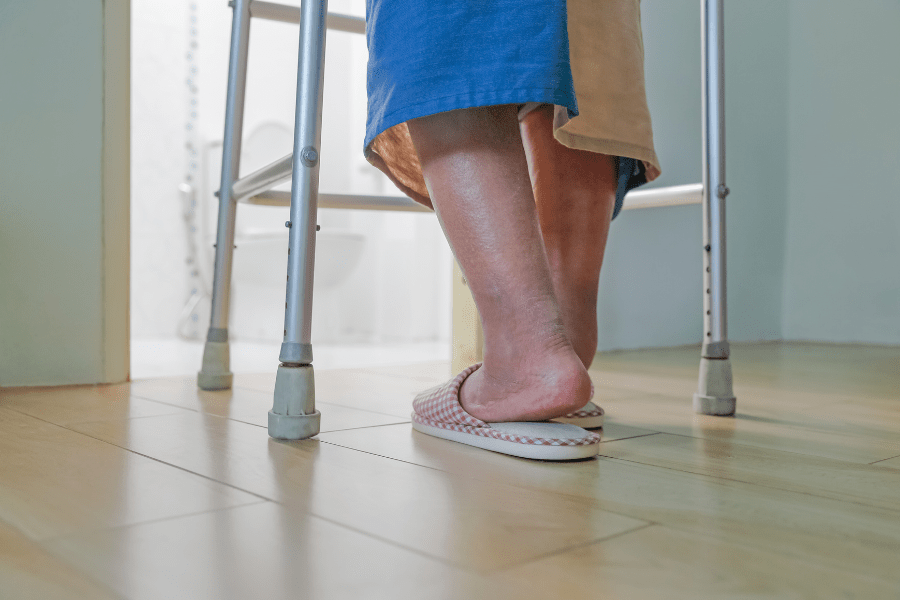
18. Bath & Shower Modifications
Walk-in showers or step-in bathtubs may be one of the most expensive home modifications for visually impaired older adults, but they’re also one of the most important.
Removing barriers — especially ones that become slippery — facilitates safety and independence. Add grab bars and nonslip treads to reduce the chance of trips and falls even more.
Additionally, if your loved one’s shower has the space for it, adding a bench can help them perform specific tasks on their own more easily. Another minor change you can make? Switching shampoo and soap bottle caps with screw-on pumps makes it easier for your loved one to open and close bottles.
Bedroom & Living Room Home Modifications For Visually Impaired Seniors
While your loved one may spend most of their time in the bedroom or living room rooms sleeping and relaxing, they’ll appreciate these minor changes that promote overall navigation and movement.
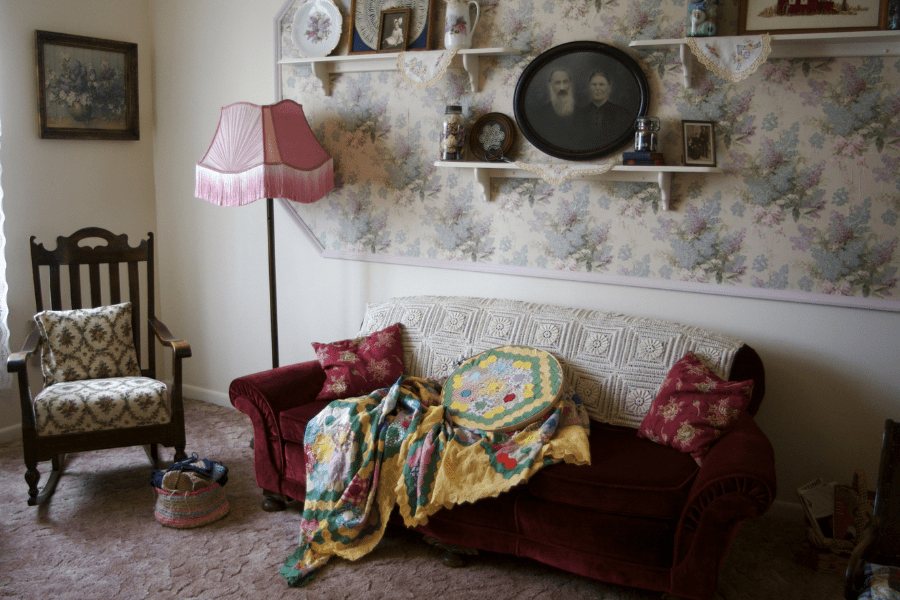
19. Distinguish Furniture, Walls & Flooring
If your loved one has their fair share of throw pillows and blankets, make sure they are off the ground to avoid the risk of falling. However, if your loved one struggles to bend over and pick things up, consider limiting the number of pillows.
20. Install Closet Lighting
Adding closet lights or improving existing ones will enhance accessibility and help your loved one find specific items quickly and easily.
21. Adjust The TV To Prevent Glare
Position your loved one’s TV so it won’t cause glare. However, you can also use curtains to help with this problem.
22. Keep Low-Vision Magnifiers Readily Accessible
If your loved one reads fine-print text, sews, or similar, keeping handled magnifiers in the places they perform these tasks can ease eye strain and make finer details more visible.
When you need more than tips on home modifications for visually impaired seniors, MeetCaregivers can help.
Hopefully, these tips will help you and your loved one create a safer, more comfortable living environment.
Diminished vision doesn’t have to stop your loved one from aging in place. But if they need a little help around the house or transportation assistance, a qualified caregiver from Meetcaregivers can help.
Help your loved ones keep their independence while giving yourself peace of mind. Give us a call at 1-888-541-1136 or email info@meetcaregivers.com.
For more information and resources for older adults, families, and caregivers, visit the Blog.
- Daniel. “Home Modifications for the Visually Impaired or Blind – The Complete Guide.” The HireAHelper Blog, Hire A Helper, 16 July 2018, blog.hireahelper.com/home-modifications-visually-impaired-blind/.
- Phillips, Quinn. “Wet AMD: Home Modifications for People With Vision Loss: Everyday Health.” EverydayHealth.com, Everyday Health, 12 Apr. 2018, www.everydayhealth.com/hs/managing-wet-amd/home-modifications-for-vision-loss/.
